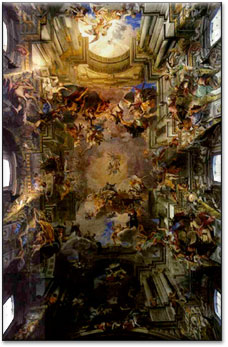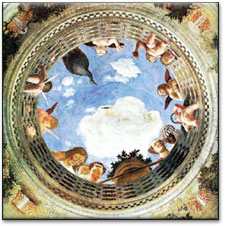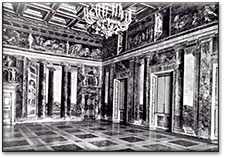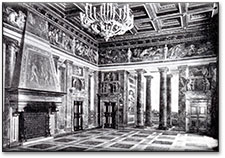We need to discuss your statement here. It contradicts earlier statements
in the book, and is not true for most viewers. I am offering a more moderated
version of the idea below. I think that I can do this without losing the essential
power of the robustness concept. Indeed, I think that you take away the power
of the robustness by implying that perspective is ineffective. Unfortunately,
the expectation that an exact projective surrogate would be seen in depth
is not confirmed. Although we usually interpret such a picture as the representation
of a three dimensional scene when we view it from the appropriate vantage
point, the impression is no more compellingly three-dimensional than if we
viewed the picture from a different vantage point. The vividness of stereopsis
is absent from this experience. Thus to view a rigorous perspective picture
from its center of projection is not enough to transform our impression of
a picture that represents depth into an experience almost indistinguishable
from the perception of objects deployed in depth. At this point, we might
conclude that only disparate images seen by the two eyes can produce the sort
of vivid experience of depth we are discussing. Such a conclusion would be
premature, as we shall presently see. Indeed, one might say that the reason
we do not see vivid depth in pictures (whether viewed with one eye or two)
is not because they fail to fulfill the necessary conditions for such perception,
but rather because pictures bear two kinds of incompatible information, namely,
information about the three-dimensional scene they represent, as well as information
about their own two dimensionality. It follows that if we could rid ourselves
of the latter, the former information should produce a vivid and compelling
experience of depth, as striking as stereopsis.
| |
|

|
|
|
 |
|
|
Fig. 4.2
Fra Andrea Pozzo, Saint Ignatius Being Received into Heaven 1691-4).
Fresco. Ceiling of the Church of Sant'Ignazio, Rome. |
Typical paintings
deviate from these ideal conditions in two ways. One is that they often have
contradictory depth cues, such as lines that do not diminish in thickness
with distance, or the texture of paint on the picture surface. Once several
such deficiencies combine to imply flatness, the picture loses its perceptual
power to evoke a depth impression. The other deviation is that the depth is
lost if the eye moves too far from the ideal center of projection. The range
of acceptability is quite large, forming a sphere (or ellipsoid) of acceptanble
locations around the geometric location, but if it is too extreme the sense
of spatial layout is lost. The typical viewing distance of perspective constructions
is about one picture width, far closer than we normally view pictures. Most
of the pictures in this book, for example, are 10 cm wide, but you are probably
reading the book from about a 50 cm distance, five times further away. One
very near-sighted readers can get clear vision at a distance of 10 cm, so
few people can experience these reproductions with the eye correctly located
at the center of projection. The situation in art galleries is usually similar.
We view paintings about a meter wide from a distance of several meters, with
both eyes open and often with a strong highlight on the canvas making the
painted surface very evident.
One way to reduce the noticeability of the surface of a picture is to have
the spectator view the picture from a long distance away. If the picture is
so large as to enable the spectator to view the picture from afar, stereoscopic
vision, which can under some conditions diminish the experience of depth by
supplying us with information regarding the flatness of the picture plane,
less effective because of the distance. I strongly dispute
the Comerford and Ono claim, but stereo obviously gets weaker with distance
So if the spectator's eyes are approximately at the center of projection of
the picture and the picture plane is distant, we should perceive the picture
in vivid depth. The typical work of art based on this principle is a wall
or ceiling painting. It represents a scene in an architectural setting that,
even though imaginary, is a continuation of the real architecture of the hall.
The best example is Pozzo's ceiling fresco in the Church of Sant'Ignazio in
Rome (Figure 4.2. The painting is a very precise central projection of an
imaginary architecture onto the hemicylindrical ceiling of the church, which
uses a center of projection at the eye level of a person standing on a yellow
marble disk in the middle of the nave.2 Maurice Henri Pirenne in
his important book Optics, Painting, and Photography (1970) writes
about Pozzo's ceiling:
The photograph, taken from the relevant yellow marble disk, shows the painting
as it is meant to be seen. It shows little of the real architecture of the
church, except the windows. To the spectator standing on the marble disk,
the painted architecture appears in three dimensions as an extension
of the real architecture. This photograph fails to give the overwhelming impression
thus produced in the spectator by this vast painting ...
| |
|

|
|
|
 |
|
|
Fig. 4.3
Andrea Mantegna, ceiling fresco (completed 1474). Camera degli Sposi,
Palazzo Ducale, Mantua |
The result of all this work is striking
... from the floor, the spectator is unable to see the painted surface, qua
surface. It is impossible to determine where the ceiling surface actually
is. From the position marked by the yellow marble disk, the arches supported
by columns at both ends of the ceiling are seen to stand upright into space.
They are seen in three dimensions, with a strength of illusion similar to
that given by the stereoscope ... (Caption of Figure 7.5, p. 81; p. 84)
The Pozzo ceiling is the pinnacle Actually,
I think it culminated in Tiepol, so I suggest a different word of a
tradition of illusionistic painted architectures begun by Mantegna.3
In the Ducal Palace in Mantua (Figure 4.3), he had painted an illusionistic
parapet that appears to break through the ceiling. Around it, in extreme foreshortening,
we see several putti4 precariously perched on a narrow
ledge and other figures peering down over the parapet. Almost half a century
later, Peruzzi undertook a far more ambitious exercise in illusionistic imaginary
architecture. On the walls of a room on the second floor of the Roman villa
he designed for Agostino Chigi, the Pope's banker, he painted frescoes that
represent balconies from which one can see beautiful views of Rome (Figure
4.4).
| |
| Box 4.1 Photographing
illusionistic walls: Most of the published photographs
of this wall fresco do not do justice to the power of the illusion
it imparts, because they are not taken from the center of projection,
which is not in the middle of the room, but in the doorway across
the room from the right-hand door seen in Figure 4.4 . For this
reason, the imaginary architecture looks in these photographs
as if it were askew with respect to the rest of the room. An exception
is shown in Figure 4.5. See also Footnote 3, Chapter
5. |
|
Neither of these works is extensive enough to provide an illusion as powerful
as Pozzo's, nor did either artist prescribe an ideal vantage point from which
the painting ought to be seen.
A second way to diminish the impact of cues for flatness was discovered about
the middle of the seventeenth century when there flourished in the Netherlands
a popular art - the "perspectyfkas," the perspective cabinet. Some
of its practitioners were major artists of the Delft School, such as Pieter
de Hooch and Jan Vermeer.5 Pirenne describes one of them:
There is in the National Gallery in London a cabinet containing two peep-shows
painted by S. van Hoogstraten (1627-78). One of these peep-shows [reproduced
in Mastai, 1975, plate 1971] represents a seventeenth century Dutch interior
consisting of a hall with a black and white tiled pavement, opening on two
furnished rooms with a view of a street and a canal. All this appears in three
dimensions when viewed through the peep-hole. This peep-show looks very much
like a real interior, extending far beyond the dimensions of the cabinet.
The scene is painted in perspective on the inside surface of the box, from
one single centre of projection, the centre of the peep-hole. The painting
is carried over in a continuous fashion from one wall of the box to another.
In the hall the tiles, two chairs and a dog are painted partly on the wall,
and partly on the floor of the box. It is hardly possible to tell on which
surface of the cabinet the various parts are painted. When something of the
actual wall of the cabinet can be distinguished, the painted view is seen
`through' the wall. (1970, p. 85, footnote I; see also Wheelock, 1977)
 |
|
 |
 |
|
 |
LEFT:Fig. 4.4
Baldassare Peruzzi, fresco (ca. 1515). Salla delle Prospettive, Villa
Farnesina, Rome. Photograph taken from center of room see Figure 4.5
RIGHT:Fig 4.5 Peruzzi, fresco. Same as Figure 4.4 except that photograph
was taken from center of projection of painting |
